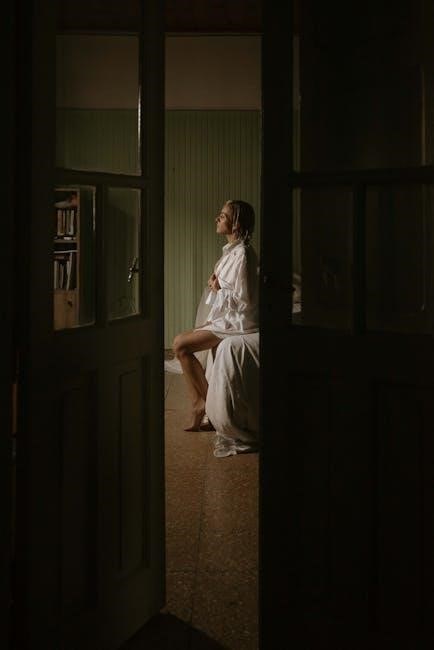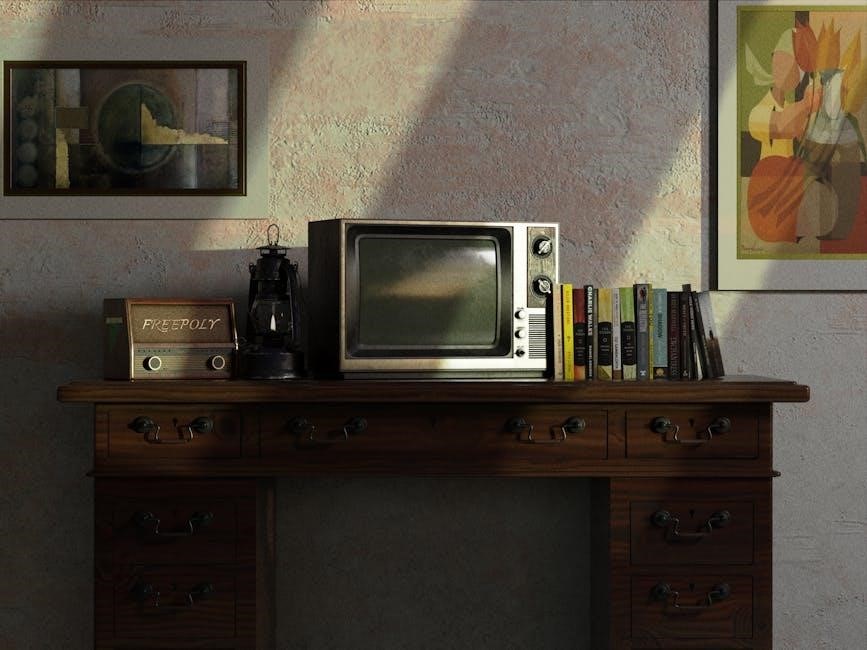Giovanni’s Room, published in 1956, is a poignant exploration of love, identity, and moral struggle, set in 1950s Paris. It follows David, an American man, and his complex relationship with Giovanni, an Italian bartender, delving into themes of sexuality, guilt, and self-discovery. The novel is celebrated for its vivid portrayal of emotional turmoil and its unflinching examination of societal norms, making it a landmark in LGBTQ+ literature.
1.1 Overview of the Novel
Giovanni’s Room, published in 1956, is a tragic love story about an American man, David, and his affair with Giovanni, an Italian bartender in Paris. The novel explores themes of identity, sexuality, and moral conflict, set against the backdrop of 1950s Europe. Through vivid imagery and emotional depth, Baldwin examines the consequences of societal norms and personal choices. The book opens with David reflecting on his past, unraveling a narrative of love, loss, and self-discovery that continues to resonate with readers today.
1.2 Historical Context of the Novel
Giovanni’s Room is set in 1950s Paris, a city that offered relative freedom for artists and expatriates but still grappled with rigid social norms. The post-war era influenced the novel’s themes of identity and moral struggle, as societal expectations clashed with personal desires. Baldwin’s work emerged during a time of heightened racial and sexual tension, making the novel a bold exploration of marginalized voices. The historical context underscores the challenges faced by characters navigating love, race, and sexuality in a restrictive period. This backdrop enriches the novel’s emotional depth and societal critique.
1.3 James Baldwin’s Literary Style
James Baldwin’s prose in Giovanni’s Room is renowned for its lyrical intensity and poetic precision. His writing seamlessly blends philosophical introspection with vivid descriptions, creating a deeply immersive narrative. Baldwin’s dialogue is sharp and evocative, capturing the complexity of human relationships. His use of language is both elegant and raw, reflecting the emotional turmoil of his characters. The novel’s narrative structure, often non-linear and introspective, enhances its psychological depth. Baldwin’s style is a masterful blend of beauty and brutality, making his work both haunting and unforgettable.

Themes in Giovanni’s Room
Giovanni’s Room explores identity, love, race, isolation, and moral struggles, delving into the human condition through its complex narrative and emotional depth.
2.1 The Struggle with Identity
In Giovanni’s Room, the struggle with identity is central, particularly through David’s internal conflict regarding his sexuality and cultural background. His journey reflects the universal human search for self-acceptance and belonging, while grappling with societal expectations. Baldwin masterfully portrays identity as fragmented and fluid, emphasizing the tension between desire and repression. This struggle is not just personal but also symbolic, resonating with broader themes of alienation and the quest for authenticity in a world that often demands conformity.
2.2 Love and Its Consequences
In Giovanni’s Room, love is depicted as both redemptive and destructive, shaping the characters’ lives profoundly. David’s relationship with Giovanni exemplifies the intense passion and vulnerability of love, yet it is doomed by societal norms and internalized prejudices. Baldwin explores how love can liberate and imprison, highlighting the emotional and psychological turmoil it provokes. The novel illustrates the consequences of unrequited and forbidden love, revealing its power to both uplift and devastate, leaving lasting scars on those who experience it.
2.3 Race and Its Role in the Novel
Race subtly yet significantly influences the narrative of Giovanni’s Room, though it is not the central focus. Baldwin explores how racial identity intersects with sexuality and societal expectations, particularly through David’s internalized biases. The novel reflects Baldwin’s broader critiques of racial hierarchies and the psychological toll of discrimination. While the story is set in Paris, offering a departure from the overt racism of 1950s America, race remains a silent undercurrent, shaping characters’ perceptions and interactions in profound ways that resonate with Baldwin’s broader literary themes.
2.4 Isolation and Loneliness
Isolation and loneliness are pervasive themes in Giovanni’s Room, reflecting the characters’ emotional disconnection. David’s internal conflict and fear of societal judgment lead to self-imposed isolation, while Giovanni’s circumstances trap him in a life of solitude. Their relationship, though passionate, is marked by emotional distance, exacerbating their loneliness. The novel portrays isolation as both a consequence of societal norms and a personal choice, highlighting the devastating effects of disconnection in a world that often rejects those who defy conventions.
2.5 Moral Struggles and Guilt
In Giovanni’s Room, moral struggles and guilt are deeply intertwined with the characters’ experiences. David grapples with internalized shame and bisexual identity, leading to self-loathing and emotional turmoil. His engagement to Hella and affair with Giovanni create a web of deceit, heightening his guilt. Giovanni, too, faces moral dilemmas, particularly in his relationship with David, which is marked by betrayal. Baldwin explores how societal expectations and personal choices foster guilt, ultimately leading to destructive consequences and emotional alienation for both characters.

Key Characters in Giovanni’s Room
The novel focuses on David, Giovanni, Hella, and the Hadleighs, exploring their complex relationships, inner conflicts, and the emotional turmoil that defines their lives.
3.1 David: The Protagonist
David, the narrator, is a young American expatriate grappling with his sexuality and identity. His internal conflicts and moral ambiguities drive the story, as he navigates a complicated relationship with Giovanni. His struggle to reconcile his desires with societal expectations reflects broader themes of alienation and self-discovery. Through his journey, Baldwin explores the tension between David’s American upbringing and his European experiences, highlighting his emotional turmoil and ultimate tragic choices.
3.2 Giovanni: The Lover
Giovanni, an Italian bartender, is a central figure in David’s life, embodying passion and vulnerability. His working-class background and emotional depth contrast with David’s privilege and repression. Giovanni’s love for David is genuine, yet his openness challenges David’s internalized homophobia. Their relationship is marked by intensity and tenderness, but ultimately doomed by societal norms and David’s inability to embrace his true self. Giovanni’s tragic fate underscores the novel’s exploration of love, identity, and the devastating consequences of denial.
3.3 Hella: The American Fiancée
Hella, David’s American fiancée, represents a life of conformity and societal expectations. Her character embodies the traditional values David feels pressured to uphold. Unaware of David’s relationship with Giovanni, Hella symbolizes the illusion of normalcy David clings to. Her presence highlights the tension between David’s internal conflict and the external demands of heteronormativity. Through Hella, Baldwin explores themes of identity and the constraints imposed by societal norms, contrasting her with the passionate yet doomed relationship between David and Giovanni.
3.4 Mr. and Mrs. Hadleigh: The Bar Owners
Mr. and Mrs. Hadleigh, the enigmatic owners of the bar where Giovanni works, serve as subtle yet significant figures in the novel. Their observant nature and quiet judgment create tension, particularly in their interactions with Giovanni. The Hadleighs represent a moral scrutiny that heightens the novel’s themes of guilt and societal expectations. Their presence underscores the oppressive atmosphere surrounding Giovanni’s life, adding depth to the narrative’s exploration of human complexity and moral ambiguity.

Historical Context and Setting
Set in 1950s Paris, the novel reflects the city’s vibrant yet socially rigid post-war atmosphere, influencing the characters’ struggles with identity, race, and societal expectations.
4.1 Paris in the 1950s
1950s Paris, as depicted in Giovanni’s Room, was a city of contrasts, blending artistic freedom with rigid social norms. The post-war era brought a sense of liberation, yet societal expectations remained oppressive, particularly for marginalized groups. Baldwin uses Paris as a backdrop to explore themes of identity, race, and sexuality, highlighting the tension between the city’s bohemian allure and the isolating effects of its judgmental culture. This setting profoundly shapes the characters’ experiences and internal conflicts, reflecting Baldwin’s own observations of the city during his time there.
4.2 The Social Norms of the Time
The 1950s were marked by rigid moral expectations, particularly regarding sexuality and race. Society demanded conformity to traditional roles, and any deviation was met with judgment or exclusion. In Giovanni’s Room, Baldwin portrays the suffocating impact of these norms on his characters, especially their internalized homophobia and fear of societal rejection. The era’s strict codes of behavior heightened the characters’ isolation, as they struggled to reconcile their desires with the expectations imposed upon them. This tension underscores Baldwin’s critique of hypocrisy and the cost of conformity.
4.3 The Influence of the Post-War Era
The post-war era shaped the novel’s themes of disillusionment and societal upheaval. The late 1940s and 1950s saw a rise in consumerism and rigid social expectations, contrasting with the personal freedoms often associated with post-war Europe. This duality influenced Baldwin’s exploration of identity and repression. The era’s moral conservatism and emerging countercultures created a backdrop for the characters’ internal conflicts, particularly their struggles with sexuality and societal expectations. This historical context adds depth to the novel’s portrayal of individual and collective alienation in a changing world.

Literary Devices and Techniques
Baldwin employs rich imagery, metaphors, and symbolism to explore themes beyond the surface narrative, crafting a layered, emotionally resonant story in Giovanni’s Room.
5.1 Use of Imagery and Symbolism
In Giovanni’s Room, Baldwin masterfully employs imagery and symbolism to convey emotional depth. The room itself serves as a symbol of confinement, isolation, and hidden truths. Baldwin’s vivid descriptions, such as the dimly lit bar and the sparse, cold spaces, reflect the characters’ inner turmoil. The contrast between light and darkness symbolizes moral struggles and repressed desires. These elements enrich the narrative, offering layers of meaning that resonate deeply with themes of identity and alienation, making the novel a profound exploration of the human condition.
5.2 The Role of Dialogue in the Novel
Dialogue in Giovanni’s Room plays a pivotal role in revealing character dynamics and emotional depth. Baldwin’s conversations are sharp, evocative, and often laced with tension, reflecting the strained relationships and inner conflicts of the characters. Through dialogue, Baldwin explores themes of identity, desire, and repression, allowing readers to witness the emotional struggles firsthand. The directness of speech contrasts with the complexity of the characters’ unspoken thoughts, creating a sense of raw authenticity and heightening the novel’s emotional impact.
5.3 Baldwin’s Narrative Structure
James Baldwin’s narrative structure in Giovanni’s Room employs a non-linear, introspective approach, blending past and present to mirror David’s emotional turmoil. The novel begins with David reflecting on his past, creating a sense of immediacy and depth. Baldwin’s use of flashbacks and shifting perspectives heightens the tension, allowing readers to piece together the narrative alongside David. This structure underscores the fragmented nature of his identity and the inevitability of his choices, making the story both deeply personal and universally resonant.

The Significance of the Title
Giovanni’s room symbolizes confinement, secrecy, and emotional isolation, reflecting the protagonist’s internal struggles and societal constraints. It embodies themes of identity, guilt, and the fragmented self.
6.1 The Room as a Symbol
The room in Giovanni’s Room serves as a powerful symbol of confinement and secrecy. It represents the hidden, intimate space where David and Giovanni’s relationship unfolds, away from societal judgment. The cramped, poorly lit room mirrors the emotional suffocation and isolation felt by the characters. It symbolizes the internal struggles of identity, the fear of exposure, and the tension between desire and societal expectations. The room becomes a refuge and a prison, reflecting the characters’ inability to escape their circumstances and the oppressive norms of the time.
6.2 Giovanni’s Room as a Metaphor
Giovanni’s room functions as a metaphor for the characters’ inner lives and societal constraints. It represents the hidden spaces where identity, desire, and secrecy intertwine. The room symbolizes the isolation and confinement imposed by societal norms, as well as the internal struggles of the characters. It mirrors the emotional and psychological states of David and Giovanni, reflecting their attempts to navigate their true selves amidst the pressures of external expectations. The room becomes a metaphor for the closets of identity and the invisible walls of societal judgment.

James Baldwin’s Background
James Baldwin was a renowned American novelist, essayist, and civil rights activist. Born in Harlem in 1924, he faced racial and sexual identity challenges, influencing his writing. His move to Paris in the 1940s shaped his perspective on American society, reflecting in works like Giovanni’s Room. Baldwin’s unique voice addressed race, sexuality, and humanity, making him a pivotal figure in 20th-century literature.
7.1 Early Life and Influences
James Baldwin was born in 1924 in Harlem, New York, to a poor African American family. His early life was marked by poverty and a strict religious upbringing by his stepfather, a Baptist minister. Baldwin found solace in literature and began writing at an early age. He attended DeWitt Clinton High School, where he developed his passion for writing. Influenced by authors like Richard Wright and Langston Hughes, Baldwin’s unique voice emerged, blending personal experiences with societal critiques, later shaping works like Giovanni’s Room.
7.2 Baldwin’s Views on Race and Sexuality
James Baldwin was a prominent voice on race and sexuality, often intertwined in his work. In Giovanni’s Room, he explored themes of identity, particularly through the lens of same-sex desire, which was groundbreaking for its time. Baldwin openly addressed racism and homophobia, drawing from his own experiences as a Black gay man. His work challenged societal norms, advocating for acceptance and understanding. Baldwin’s unique perspective bridged racial and sexual identities, making his writing a powerful commentary on human struggle and liberation.
7.3 The Impact of His Personal Experiences
James Baldwin’s personal experiences deeply shaped his writing, particularly in Giovanni’s Room. His childhood in Harlem, struggles with identity, and experiences as a Black gay man influenced the novel’s themes of alienation and self-discovery. Baldwin’s exile in Paris mirrored David’s journey, reflecting his own search for belonging. His intimate understanding of marginalization infused the characters with raw emotional depth, making the novel a poignant exploration of human vulnerability and the quest for authenticity.

Reception and Criticism
Giovanni’s Room initially faced controversy due to its explicit themes but was praised for Baldwin’s lyrical prose. It became a landmark in LGBTQ+ literature, celebrated for its emotional depth and unflinching honesty about identity, love, and societal norms.
8.1 Initial Reception of the Novel
When Giovanni’s Room was first published in 1956, it sparked controversy due to its explicit portrayal of same-sex relationships and racial themes. While some critics praised Baldwin’s lyrical prose and emotional depth, others condemned the novel for its perceived immorality. The book faced backlash, particularly within the African American community, where homosexuality was rarely discussed openly. Despite this, it gained a loyal readership and was recognized for its bold exploration of identity and societal norms, marking it as a groundbreaking work ahead of its time.
8.2 Modern Critical Acclaim
Giovanni’s Room is now celebrated as a groundbreaking novel in both LGBTQ+ and African American literary traditions. Critics praise its nuanced exploration of identity, race, and desire, with Baldwin’s prose hailed for its lyrical precision and emotional depth. The novel’s unflinching portrayal of human complexity has solidified its status as a classic, resonating with contemporary readers grappling with themes of identity and societal expectations. Its enduring relevance underscores Baldwin’s profound influence on modern literature.
8.3 Controversies Surrounding the Book
Giovanni’s Room has faced controversy due to its explicit portrayal of homosexuality and interracial relationships, topics considered taboo in the 1950s. Baldwin’s unflinching exploration of desire and identity challenged societal norms, leading to criticism and censorship in some circles. The novel’s frank discussion of race and sexuality also sparked debates, with some readers uncomfortable with its raw honesty. Despite this, the book remains a pivotal work, highlighting the struggles of marginalized communities and inspiring later LGBTQ+ literature.

The Novel’s Legacy
Giovanni’s Room has left a lasting impact on LGBTQ+ literature and African American literary tradition. Its exploration of identity and desire remains timeless, resonating deeply today.
9.1 Influence on LGBTQ+ Literature
Giovanni’s Room has profoundly shaped LGBTQ+ literature, offering a raw, unflinching portrayal of same-sex relationships and identity. Published in 1956, it challenged societal norms and provided representation when queer voices were marginalized. Baldwin’s exploration of desire, internal conflict, and societal rejection resonated deeply, setting a precedent for future authors to explore queer themes authentically. Its emotional depth and unapologetic narrative have made it a cornerstone of LGBTQ+ literary history, inspiring generations of writers and readers alike.
9.2 Its Role in African American Literary Tradition
Giovanni’s Room holds a significant place in African American literary tradition, as James Baldwin masterfully intertwined race, identity, and social critique. While the novel focuses on same-sex relationships, its exploration of alienation and societal oppression mirrors broader themes in African American literature. Baldwin’s unflinching prose and emotional depth continue to influence authors addressing race and sexuality, solidifying his legacy as a trailblazer in both LGBTQ+ and African American literary circles. His work remains a powerful voice in exploring the intersections of identity and societal norms.
9.3 Continued Relevance in Contemporary Society
Giovanni’s Room remains deeply relevant today, as its themes of identity, societal expectations, and personal freedom resonate with modern readers. Baldwin’s exploration of universal human emotions transcends time, making the novel a powerful commentary on contemporary issues like gender, sexuality, and race. The struggles of its characters to navigate oppressive norms continue to mirror modern society’s challenges, ensuring the book’s enduring importance in discussions about individuality and the human condition.

Why Read Giovanni’s Room?
Giovanni’s Room offers profound insights into the human experience, blending lyrical prose with universal themes of identity, love, and societal pressures, making it a timeless read.
10.1 Universal Themes and Relatability
Giovanni’s Room captivates readers with its exploration of universal themes such as identity, love, and societal expectations. The novel’s focus on internal conflict and emotional depth transcends time and cultural boundaries, making it relatable to a broad audience. Baldwin’s portrayal of human vulnerability and the struggle for self-acceptance resonates deeply, offering insights into the complexities of the human condition. Its timeless relevance ensures that the story continues to connect with readers, inviting reflection on personal and collective experiences.
10.2 Insights into the Human Condition
Giovanni’s Room offers profound insights into the human condition, exploring themes of self-discovery, guilt, and the search for authenticity. Baldwin masterfully delves into the complexities of human emotions, revealing the inner turmoil of characters grappling with societal expectations and personal desires. The novel highlights the universal struggle to reconcile one’s true self with the world’s demands, providing a deeply human and empathetic portrayal of vulnerability and resilience. This introspective depth makes the story a compelling exploration of human nature.
10.3 The Power of Baldwin’s Prose
James Baldwin’s prose in Giovanni’s Room is a masterclass in lyrical and evocative writing. His language is both poetic and precise, capturing the intensity of human emotions and the complexity of moral dilemmas. Baldwin’s vivid imagery and nuanced dialogue elevate the narrative, creating a deeply immersive experience. His writing not only conveys the characters’ inner struggles but also reflects the broader societal tensions of his time. The power of his prose lies in its ability to evoke empathy and challenge readers to confront uncomfortable truths about identity, love, and existence.
Accessing Giovanni’s Room
Giovanni’s Room is widely available in PDF format through official sources like bookstores, libraries, and eBook platforms. Supporting official releases ensures authors receive fair compensation for their work.
11.1 Where to Find the PDF
You can find Giovanni’s Room in PDF format through various online platforms, including Amazon, Google Books, and eBook retailers. Many libraries also offer digital copies for borrowing. Additionally, some educational websites and literary databases provide free access to the novel for academic purposes. Always ensure you are downloading from authorized sources to avoid unauthorized versions and support the author’s work. Purchasing or borrowing from reputable platforms is the best way to access this classic novel legally and safely.
11.2 Importance of Supporting Official Sources
Supporting official sources when accessing Giovanni’s Room ensures that you are contributing to the literary ecosystem responsibly. Purchasing or downloading the novel through authorized platforms directly supports James Baldwin’s estate and publishers, promoting the sustainability of literary works. It also guarantees that you receive a high-quality, unaltered version of the text. Additionally, supporting official sources upholds ethical standards and combats piracy, which can harm authors and the publishing industry. By choosing legitimate sources, you respect the intellectual property rights of creators and foster a culture of integrity in literature.
11.3 Legal and Safe Download Options
To access Giovanni’s Room legally, consider purchasing the e-book or paperback from verified retailers like Amazon or Barnes & Noble. Libraries often offer free e-book loans through platforms like OverDrive. Avoid illegal downloads, as they violate copyright laws and risk exposing your device to malware. Supporting official sources ensures you receive a quality copy while contributing to the author’s legacy and the publishing industry. Always prioritize legal options to enjoy the novel responsibly and ethically.
Giovanni’s Room remains a timeless exploration of identity, love, and societal constraints, offering poignant insights into the human condition. Baldwin’s masterful prose ensures its enduring relevance and emotional depth, making it a must-read for understanding both historical and contemporary struggles.
12.1 Final Thoughts on the Novel
Giovanni’s Room remains a profound exploration of human complexity, delving into themes of identity, love, and societal constraints. Baldwin’s masterful prose captures the essence of his characters’ struggles, creating a deeply emotional and thought-provoking narrative. The novel’s timeless themes resonate across generations, offering insights into the human condition. Its unflinching honesty and lyrical beauty make it a landmark work in LGBTQ+ and African American literature. Giovanni’s Room is not just a story but a reflection of universal truths, leaving readers with a lasting appreciation for Baldwin’s genius.
12.2 The Enduring Appeal of Giovanni’s Room
Giovanni’s Room continues to captivate readers with its profound exploration of human emotions, identity, and societal constraints. Baldwin’s vivid prose and the novel’s emotional depth create a timeless connection with audiences. The universal themes of love, isolation, and moral conflict resonate across generations, making it a relatable and poignant read. The raw humanity of its characters and the evocative portrayal of 1950s Paris add layers of complexity. Its enduring appeal lies in its ability to mirror the struggles and desires of the human condition, ensuring its relevance in contemporary society.
12.3 The Lasting Impact of James Baldwin’s Work
James Baldwin’s work continues to resonate deeply, offering profound insights into race, sexuality, and the human condition. His unflinching honesty and lyrical prose have inspired generations of writers and activists. Giovanni’s Room remains a landmark in LGBTQ+ literature, challenging societal norms and exploring themes of identity and isolation. Baldwin’s legacy endures through his ability to confront uncomfortable truths, fostering empathy and sparking necessary conversations. His influence ensures his work remains relevant, guiding future writers and thinkers.
